
April 2020
Bespoke Jewellery: Everything you need to know
CONTENTS
♦ Intro
♦ Our philosophy
♦ Cost
♦ The design process
♦ Old jewellery into new
♦ Engagement rings
♦ Anniversary presents
♦ Source-it-Service
♦ Customisation
♦ Turning treasured possessions into jewellery
♦ Birthstone gifts
♦ Replication, resizing and repair
♦ Contact

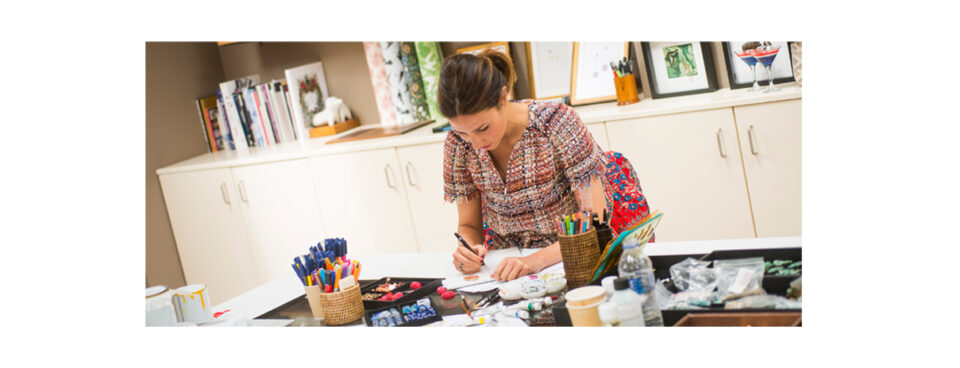
INTRO
We LOVE designing jewellery, especially the bespoke kind. Nothing says ‘special’ like a one-of-a-kind piece of jewellery that has been hand-crafted just for you.
Our unique bespoke service started out of a love for personalisation and the unique. So much of the bespoke jewellery out there seemed the same (especially in the engagement ring sector) and we wanted to break this wheel and create pieces that screamed individuality and statement, as well as reflecting the heart and soul of the recipient.
Nearly 8 years on from start-up and our bespoke jewellery services are stronger than ever. We work alongside an ever-growing number of great workshops and craftsmen; our stone dealers are top quality and price fair; we are constantly innovating and exploring new technologies and machinery to make the impossible possible; and above all we are still having fun. We are proud of what we do and how we do it, and we hope that the below will inspire you to delve confidently into the world of bespoke jewellery too, as and when the time calls.

OUR PHILOSOPHY
Here at Tessa Packard London we offer an extensive, bespoke jewellery service for both our clients in the UK and abroad. From the first conversation to final send-off, Tessa and the team are on hand to turn your jewellery dreams into sparkly reality, whether you are looking to replicate a missing earring or create a custom-designed cocktail ring.
Our bespoke jewellery philosophy is simple. We stick by it each and every time we start a new commission because it is important for us that our clients enjoy the process and receive (from start to finish) the best bespoke jewellery experience possible:
♦ Creating bespoke jewellery should be fun. It should also be informative, efficient and engaging.
♦ In our world, no commission is too big and complex, or too small and simple. We approach each new project with the same enthusiasm and care as the last.
♦ We like a challenge, whether that be design-led or cost-based. At the same time, if we know we can’t make it how you want it we’ll tell you straight up and point you in a better direction.
♦ We like enquiries and are always happy to provide potential bespoke clients with a starting quote and design for free, without any obligation to proceed.
♦ Our commission structure for any bespoke project is completely transparent and the same for everyone.
♦ Design meetings can be done in person, via email, on the phone or video call. Many of our bespoke clients live abroad so we are used to working in a manner of different ways.
♦ The client’s vision always comes first. We are on hand to lend as much (or as little) design assistance as needed. Our job is to make the jewellery of your dreams.
♦ Our jewellery is always made exclusively in the UK.

COST
Many of our clients are often surprised by the cost of commissioning jewellery. Most of the time it is less than they expected, and 99% of the time it is much less than what you would pay for ready-made jewellery in any retail shop.
Because we believe good jewellery should be accessible to everyone, we only charge what we think is fair and no more. We do not place any additional premiums on clients wishing to use our bespoke service – in fact, we love designing bespoke jewellery so much that we constantly look to make our bespoke jewellery more cost-effective and budget friendly year on year, without compromising on quality or outcome.
And whilst many bespoke jewellery designers will turn away smaller commissions, we embrace them. They motivate and challenge us to find new manufacturing solutions to solve cost-themed problems.

THE DESIGN PROCESS
Whilst every bespoke commission is different (and personalised to the individual) 99% of our projects follow the same, three phases from start to finish: The Brief, the Design Phase and finally The Execution.
THE BRIEF
We call the first phase of a bespoke commission ‘The Brief’. The sole aim here is to understand the client’s needs, wants and desires so that we can accurately translate their ideas into reality. Unsurprisingly, we do a lot of listening and asking questions at this point in the project – the more we know the better prepared we are for what comes next. Common questions we might ask include:
♦ Do you (or the recipient in question) have any metal allergies?
♦ Is this ring to be worn on the same hand as other rings, and if so, what are those rings made of?
♦ Is this something you want to wear every day, when dressing up, or only on special occasions?
♦ Might you want to use the appropriate birthstones for this commission?
♦ If this is a surprise commission, do you have a photo of the recipient? Could you describe his / her style?
♦ What sort of jewellery do you (or the recipient) wear the most and why? What do you find hard to wear or annoying to wear with regards to jewellery?
♦ Are you a careful jewellery wearer, or someone who doesn’t want to think about whether a ring will survive a night on the town?
♦ Would you like this ring to be able to be resized one day for future generations?
♦ Do you have any stones or unused jewellery in your safe that you would like to incorporate into this project?
♦ Do you know the recipient’s ring size? Might we need to resize the ring once it is gifted?
♦ What is your budget?
Whilst the last question can feel direct, it is extremely important for us to have an idea of the amount of money a client is prepared to spend before we plunge into the Design Phase. We only like to show our clients designs that are ‘in-budget’ (unless otherwise directed) as we feel it allows them to choose the one they really love, instead of worrying about whether there might be a financial surprise lurking around the corner.
Once we have a good idea of what the client is asking for, we will talk through the pros and cons of using certain metal types and gemstones, based on the information supplied in the brief. Understanding why a metal or stone is perfect for a bespoke ring or a certain bespoke necklace is just as important as understanding why another metal or stone is not. And whilst we will never insist on a particular decision, we believe it is crucial that a client is fully informed about the materials they wish to use, and any limitations that come with them.
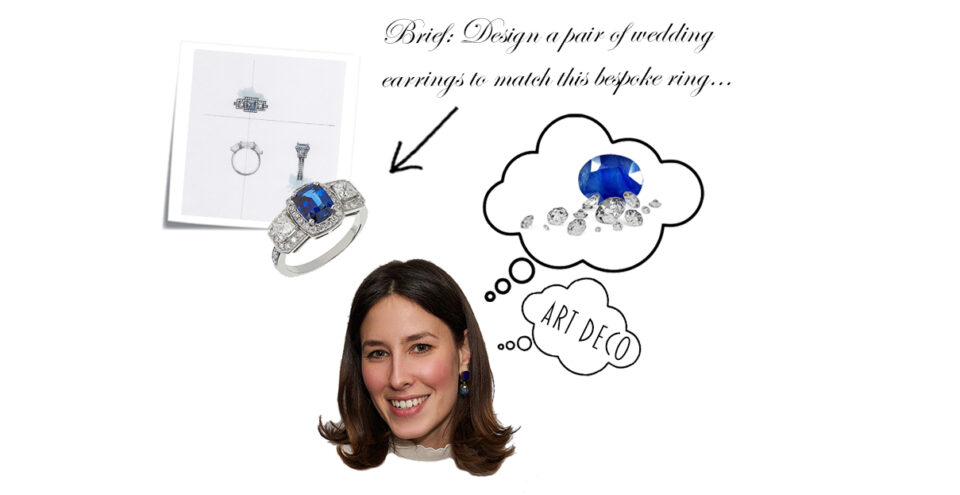
At this stage of the project we also like the take the opportunity to examine and classify any materials the client might bring in themselves, whether that be for scrap metal or to use in the commission itself. If a client is looking to turn their old jewellery into new, they may well wish to use the metal and gemstones from an old (unused) piece. We ask them to bring these materials to the brief (where possible) so we can have a look at the bits and bobs and make sure they are viable for re-use. Sometimes a client will know the exact type and quality of the metals and gemstones in their hoard; but very often than not they won’t have a clue. We can handle all and any enquiries, whether that be testing the gold purity of a ring band or finding out the exact grade of a diamond. We can also assist with any required certification, especially in the case of valuable diamonds.
Some clients also like to ‘scrap’ unused precious metal in exchange for cash. Once again, we like to handle this process for them prior to the Design Phase, as it allows our clients complete clarity when considering the budget for their commission. This is especially true when the client is reliant on this scrap cash for the bespoke project to be able to go ahead. As some clients receive more scrap cash than anticipated, and others receive less, it is useful to have this part of the process completed before moving ahead.
The last thing we like to ask our clients is ‘how involved do you want to be going forwards’? This may sound like a strange question, but the answers often vary enormously. Some clients want to be part of the bespoke story at every step, with weekly updates and photographs cataloguing every stage of the design process and manufacture; others are extremely comfortable leaving small decisions to us, such as stone sourcing and final stone selection. Ultimately, there is no right or wrong – it’s up to the client to say what they feel comfortable with based on their time, resources and interest.
DESIGN PHASE
The second stage of any bespoke commission is all about design. This is where the creative magic happens.
Step 1
Using the information provided in The Brief, Tessa will present a first round of designs for the client to critique. These designs will be 2D and either drawn on paper or created digitally. The designs will be accompanied by carefully sourced gemstones (where applicable) and will be carefully costed up prior to presentation to make sure they fall in budget with the client’s requirements.
At this step, Tessa usually provides between 4 and 7 designs for the client to critique.
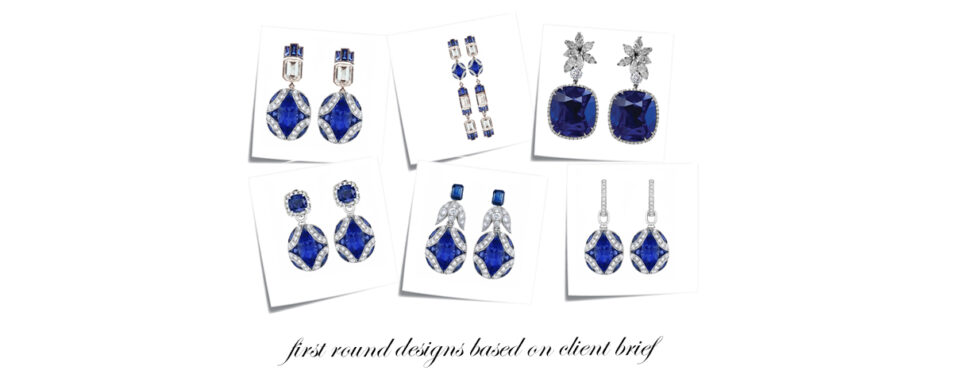
Step 2
Based on client feedback, Tessa and her team proceed forward by selecting, amending or eliminating Step 1 designs. It is completely normal for a client to want to see a further set of designs at this stage; these designs are usually tweaked variations of a favourite design from Step 1, or two or three top designs merged together. If new gemstones need to be sourced Team TP will also arrange for a new selection to be presented.
At this step, Tessa usually provides her client with between 1 and 3 designs to critique, based on the feedback from Step 1.
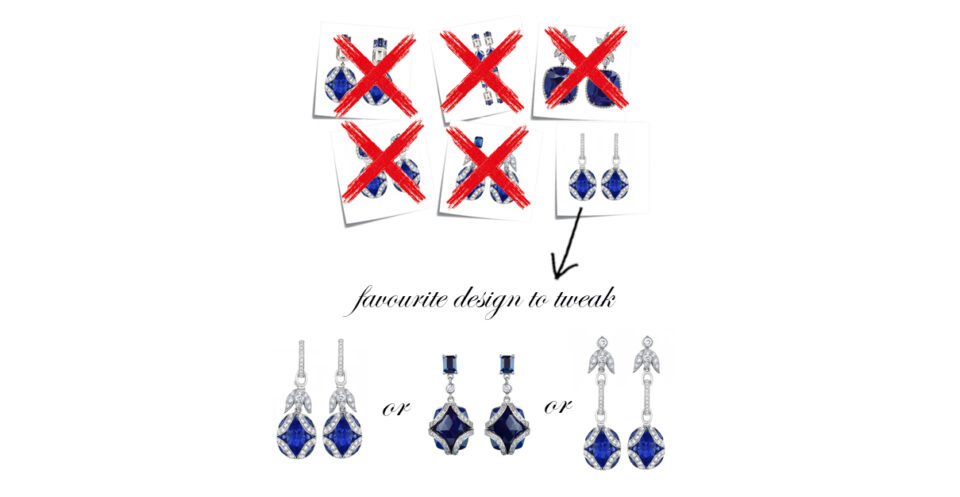
Step 3
Assuming the client is happy with a Step 2 design, Tessa will then move on to create a real-scale, paper mock-up for the client to ‘try-on’. Whilst a paper mock-up lacks the volume of the finished piece or a wax prototype, it can be extremely helpful for a client to see the scale of a ring in 2D against their finger, or the 2D silhouette of an earring against their ear lobe. Everyone’s body is different – from finger size to chest height to the positioning of a piercing on an ear. Before we go into production, it’s important that we get the dimensions of a design right, especially if the design in question cannot be easily amended once made.
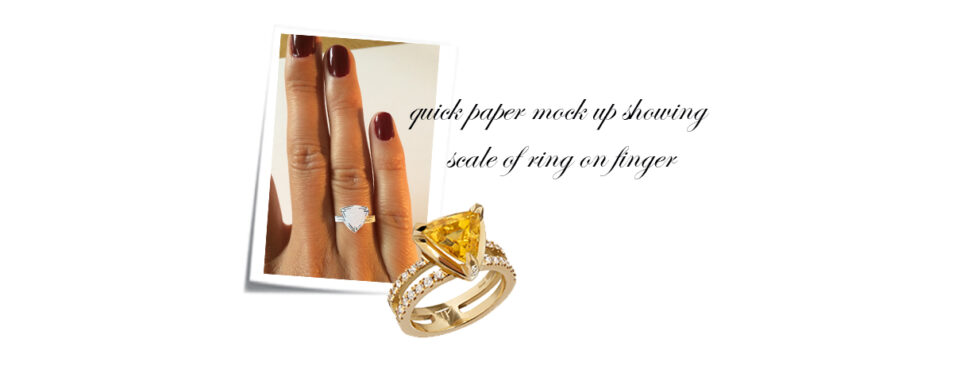
In this step, a final design is chosen and any required tweaks are made in anticipation of manufacture. The cost of manufacture is also double checked in case market fluctuations have occurred.
It is here that we also exchange Design Contracts and invoice the client for payment *
* For commissions over £3,000 we usually invoice the client for 50% of the total costs before we commence manufacture, and the final 50% prior to collection of the piece; for commissions under £3,000 we generally tend to invoice only once (invoicing the full amount), prior to commencing manufacture. With either option, the instalment or payment is non-refundable once manufacture commences.
In terms of timeframe, we usually ask clients to allow 2 – 3 weeks for The Brief and Design Phase. More complex commissions may require longer.
THE EXECUTION
It’s always an extremely exciting moment putting a bespoke design into manufacture. There’s nothing quite like seeing a 2D design transform into a 3D reality. We usually ask clients to allow 4 – 6 weeks for the manufacture of a simple bespoke commission and approximately 6 – 9 weeks+ for something a little more complicated (for example a project that requires stone cutting).
Depending on the nature of the project (and the client’s personal requirements), we begin the actual execution of a piece in one of two different ways: the first being ‘straight to the bench’ and the second being CAD (Computer Aided Design).
Making a piece of jewellery at the bench is the most traditional method. Using technical jewellery drawings, a skilled silversmith or goldsmith will use their tools ‘at the bench’ to recreate the piece in by hand. This option works really well for most designs but has one or two limitations. Generally speaking, bench work it is not as well suited to complex, mechanical designs (which benefit from computer precision) and this option also does not allow the client to ‘see’ the finished piece in the round prior to manufacture.

Creating a design with CAD is an extremely useful step for clients who find it hard to visualise how a 2D drawing will look in 3D. With CAD, you can see a bespoke jewellery design from all angles, which means the client can double check that they are happy with its appearance before making the piece. If a client requires further reassurance, we are always able to create a 3D wax prototype of the piece using 3D printing, and from that we can even create a silver model for them to physically try on should they wish. Once a client has approved the CAD design (and any wax or metal prototypes) the design is printed in wax and cast in the metal of choice. It is then set with stones, polished, engraved and hallmarked as required.
Whilst CAD is undoubtedly beneficial in many ways, it does have a couple of downsides. As a stand-alone exercise (ie. for those who want to see a design in the round prior to making jewellery at the bench) it does add some cost to a commission – although arguably this cost can be well worth it for client peace of mind. CAD jewellery is generally cast from a wax or mould; cast jewellery can be harder to re-shape or re-size than bench-made jewellery. The CAD process can also increase the time it takes to manufacture a piece of bespoke jewellery. We usually ask clients to allow for a further 3 weeks as some designs are complicated and require effort to accurately replicate on the computer.
One a bespoke piece is completed in full, and is ready to be delivered, we offer our clients the option of a complimentary insurance certificate, as well as copies of any technical drawings should they wish. It is at this point that we also invoice the client for final payment, if required.
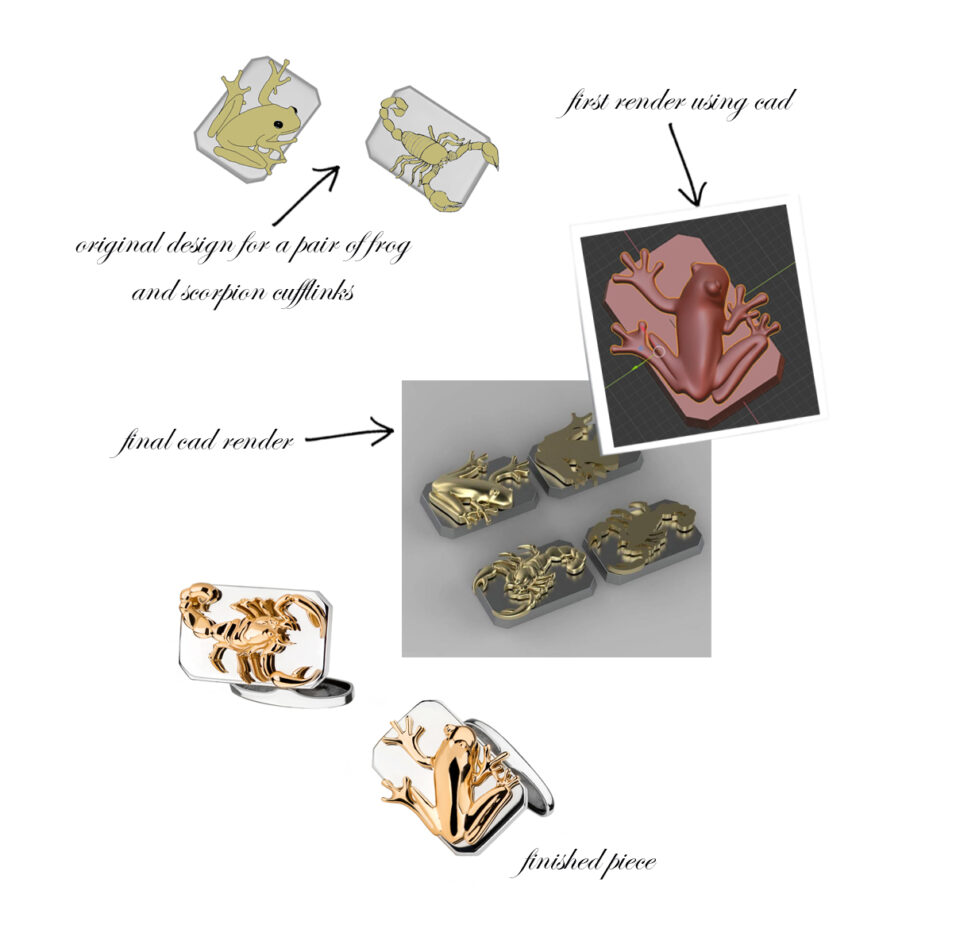
OLD JEWELLERY INTO NEW
Fashions change. The jewellery your mother likes to wear on her fingers may not be the same as what her own mother wore, and most likely is not anywhere near the same as what you think is beautiful or like to wear either. Taste can often pose a problem when people are given jewellery or inherit jewellery that is not very ‘them’ – the gift is of course received gratefully, but what next?
A generation ago there was great trepidation about pulling apart and dismantling gifted or inherited jewellery. Thankfully, today, sentiments have changed, and more and more Tessa Packard London clients are enjoying the perks of turning old, unused or unloved jewels into shiny, new heirlooms.
The brilliant thing about jewellery in general is that it lends itself extremely well to renovation. Unlike designer shoes and antique furniture, you can quite easily remodel of an old piece of jewellery without much complication, and without compromising the value of its parts. Whether you are looking to adapt, amend or totally make over a pair of earrings or redesign a gold necklace, anything is possible.
When a client is looking to transform old jewellery into new, we generally advise them to bring along with them any and all pieces of jewellery that they may wish to renovate. That way we are able to see what gemstones we have to play with that may match the brief. Very often, a client looking to transform a brooch into a cocktail ring will have the perfect centre stone for the bespoke ring embedded in an unworn pendant. The more material we have to work with the better, and this is especially true if budgets are tight.
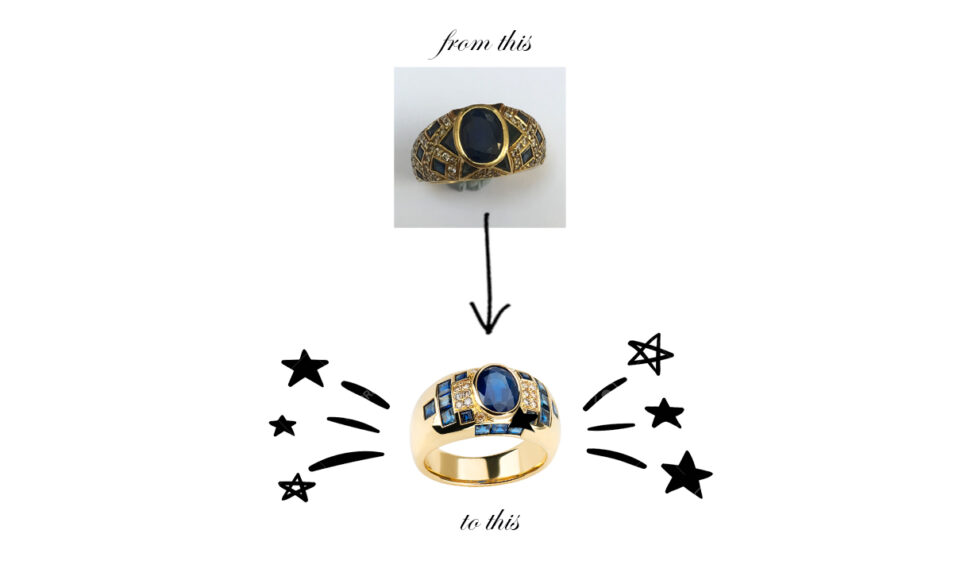
Gemstones are superb at being ‘recycled’. Carefully unpicked from their original settings, these miniature treasures can be re-cut or re-polished as needed, and then re-set into ‘much-more-you’ designs to enjoy. Many clients aren’t even sure of the calibre or quality of the stones they have inherited, so if requested, we can happily arrange for them to be professionally valued or certified by one of our many associated gemmologists.
Whilst we try and make every effort to use the original metal from an ‘old’ piece, sometimes it just isn’t possible due to volume (there isn’t enough available to create the new design), quality or type. On those occasions we advise our clients to either scrap the old metal for cash (which they can put towards the cost of the commission) or keep hold of the metal for a future bespoke commission.
To give you an idea of what is possible, here are two of our favourite old-to-new jewellery commissions:
♦ Pearl and diamond zig-zag earrings and pearl and black sapphire drop earrings //
The client came to us with a string of antique pearls that she had inherited from her mother. She felt the pearl necklace was a bit too old fashioned for her and asked that we pull it apart to create two pairs of modern earrings that celebrated the pearl. She was open to us using other gemstones but wanted to keep the palette relatively neutral to make sure the two designs were relatively unfussy and could be worn on a number of occasions. After a first round of designs we settled on two: a drop earring for the everyday, and a slightly more statement chandelier-style pearl earring incorporating pave-set diamonds. Both can be dressed up or dressed down and showcase her mother’s pearls beautifully.

♦ 18ct gold and diamond engagement ring //
This client came to us with an inherited solitaire diamond ring which she had been given by her husband-to-be as an engagement ring. Although she loved the central diamond, and appreciated the importance of this family ring, she wanted to give it a touch of her own by either by creating a ring jacket to fit it or by adding further detail around the solitaire. Part of the brief was to make sure any changes were extremely sympathetic and sensitive to the old ring in order to try and maintain as much of its original structure and integrity as possible. As a result, we chose to keep the original band and diamond in place, building instead around it to create a more Art Deco looking piece. The result is a bespoke engagement ring truly worthy of both the past and the present.
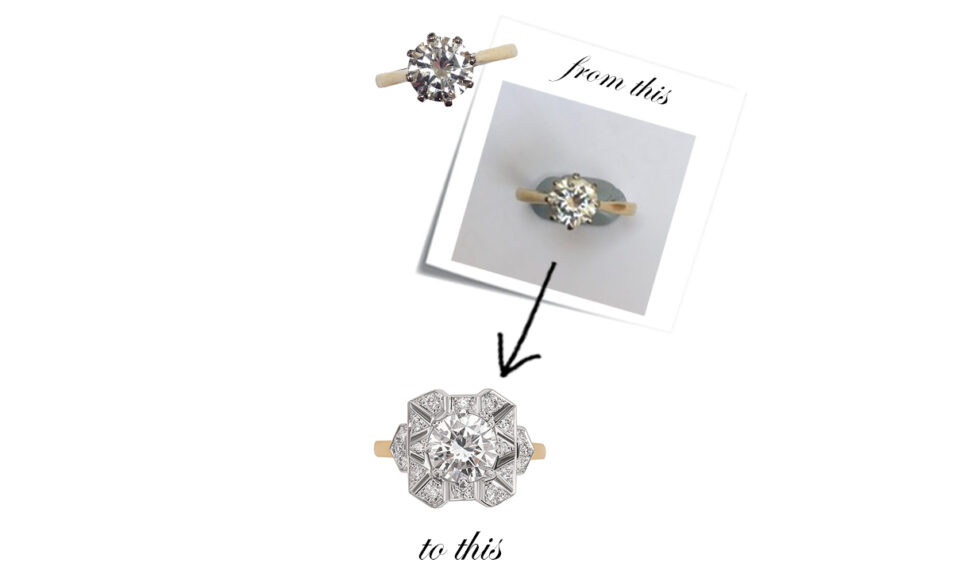
ENGAGEMENT RINGS
The sourcing of an engagement ring can be a seriously stressful task, and often unnecessarily expensive. The thought of perusing rows and rows of rings in endless, impersonal jewellery shops before spending a fortune on a piece is enough to make anyone go mad. In our world there is a much better option, and it’s called the Tessa Packard London bespoke engagement ring.
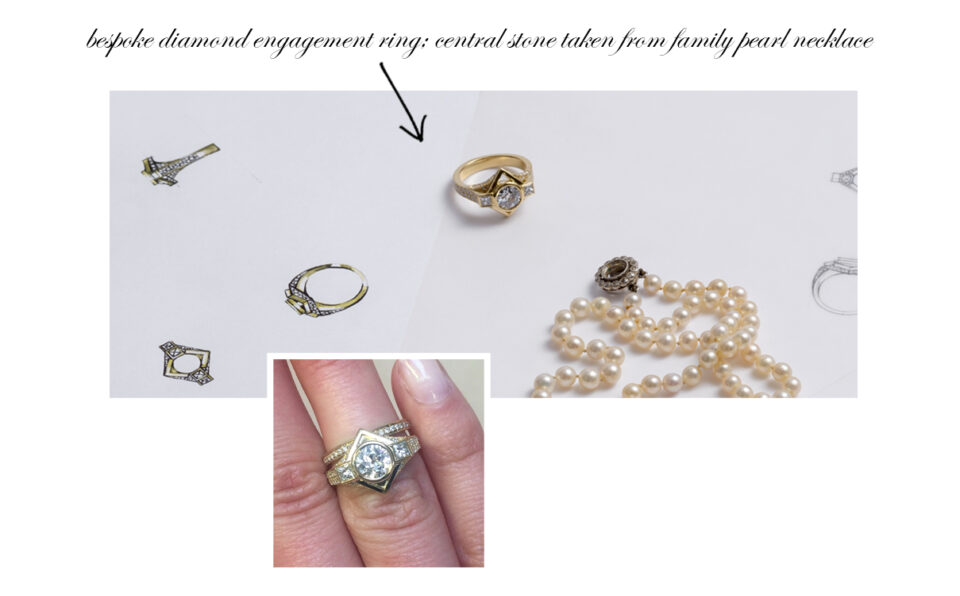
Marrying dedicated service with expert advice and unique design skills, we believe our bespoke engagement ring offering to be one of the best out there. It’s a true privilege to be entrusted with an engagement ring commission and we like to honour that privilege with warmth, honesty and integrity.
Whatever the style, look or feel of the ring you are after, we can deliver in a fun, inspiring, courteous, transparent, efficient and cost-effective manner. The only thing we can’t do is cook one up overnight.
Our bespoke engagement rings start at £3,000. Each one is designed from scratch and utterly unique to the client. Generally speaking, we offer three main bespoke engagement ring project options (although we are of course happy to tailor make the process to individual needs):
♦ The Full Surprise
In this scenario, the client tells us what their loved one is like, how much they want to spend, and we design a ring for the betrothed-to-be. The ring can always be altered post proposal, but there will be an additional cost to do this.
♦ The Half / Half
The client tells us what their loved-one is like, how much they want to spend, and we pick out a stone together and get it set into a very simple band for the proposal. Once engaged, both parties will work with Tessa and Team TP to design and make the ring. The stone is a surprise, the ring isn’t.
♦ The Safety Comes First Option
The client and their loved one come to see Tessa together to discuss what they want and how they want it. Some couples prefer to talk about budget openly, others request a degree of discretion, and we can work with either scenario. Once a budget is set, Tessa and her teamwork with the couple to create the bespoke engagement ring of their dreams.
To give you an idea of what we can do here is a selection of some of our past bespoke engagement rings:

We are also able to offer bespoke wedding bands to fit or match any of our custom-made engagement rings. Wedding bands traditionally come in the following four, standard shapes:
♦ D-shape – Flat on the inside and curved on the outside, giving the band a ‘D’ shape cross section.
♦ Court – Gently rounded on both the outside and inside, making it a very comfortable fit. Probably the most traditional of all the band shapes. This band style is also sometimes referred to as ‘comfort fit’.
♦ Flat – Flat on both the inside and outside, this ring is the most contemporary looking of the four styles.
♦ Halo – This ring has a fully rounded profile, like a doughnut.

However, we can also accommodate any design of wedding band and we are always delighted to explore different, non-traditional ideas with our clients. One of the most popular, alternative options to the above is bespoke eternity rings, set with diamonds or other gemstones to complement the engagement ring. Eternity bands make perfect wedding bands and can look great when worn on their own (for example on holiday when it may not be appropriate to wear a more noticeable engagement ring).
ANNIVESARY PRESENTS
Happy wife, happy life, or so the saying goes.
Whilst commissioning a piece of bespoke jewellery every year might be out of the question, we like to think that the special person in your life deserves something memorable and thoughtful when it comes to the ‘big ones’.
Traditionally, anniversaries have always been associated with a specific material, starting with paper for the first anniversary and diamonds for a 60th wedding anniversary. Below is a list of the most notable ‘big ones’, but they are by no means exclusive to what’s possible:
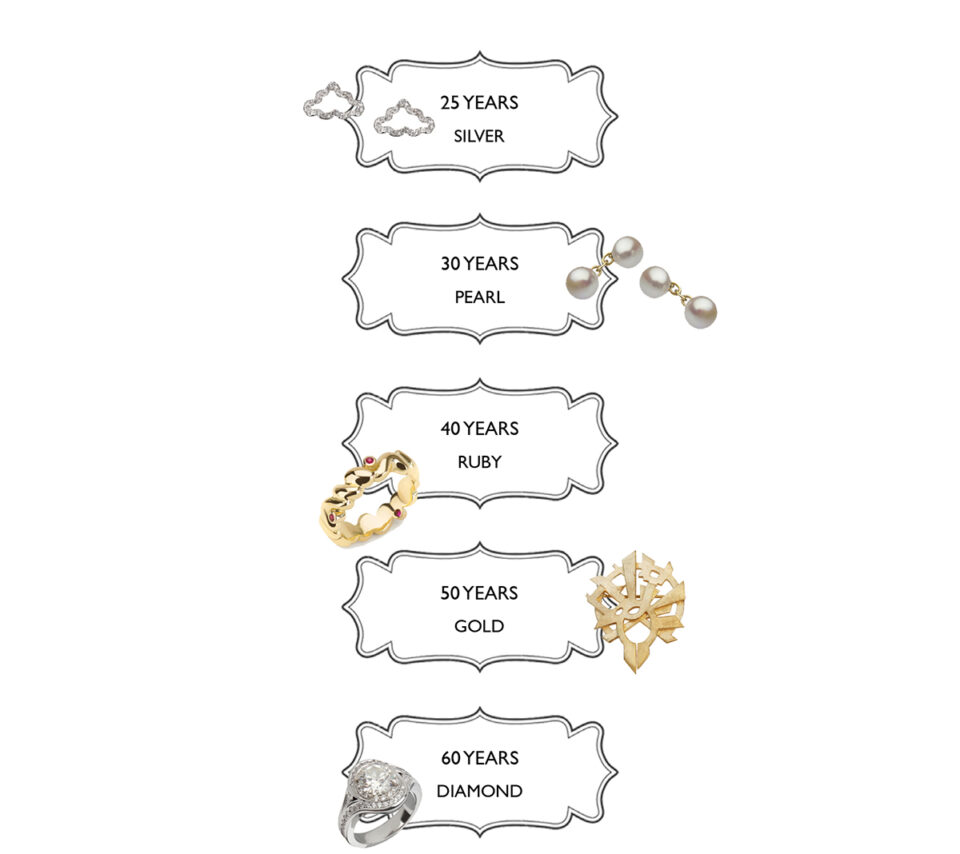
In our opinion, bespoke jewellery is always preferable to the shop-bought kind when it comes to important occasions. After all, if your loved one is one-of-a-kind, shouldn’t the jewellery you give them be too? Whether a client is looking to make a full suite of bespoke ruby jewellery, a commemorative eternity ring or a pair of everyday pearl earrings we are always on hand to show our clients various ideas and creative options to make that anniversary present truly unique and special.
Examples of past silver wedding anniversary, gold wedding anniversary, ruby wedding anniversary and one-year-married anniversary bespoke jewellery commissions can be found HERE.
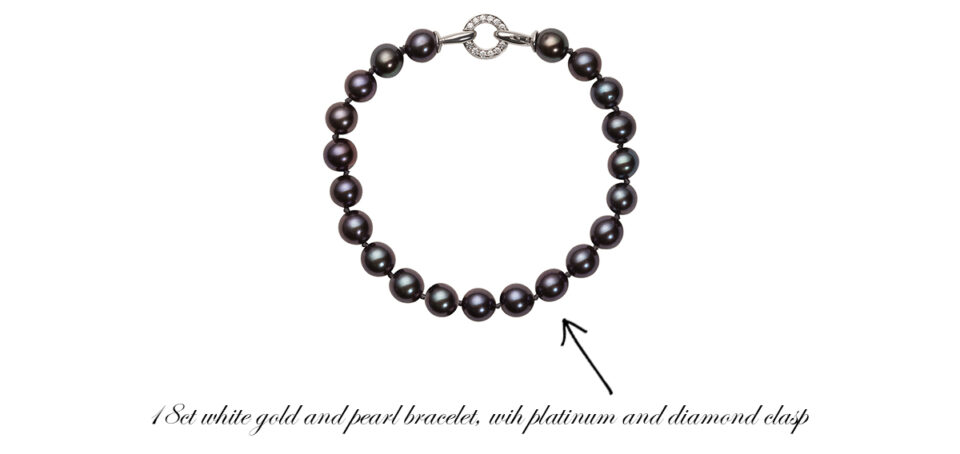
SOURCE-IT-SERVICE
Sometimes it can be difficult to know what to get a godchild for her christening when she’s only 6 months old. Would she prefer a bespoke silver necklace or a bespoke gold ring? Is her style going to be Art Deco inspired or punk modern?
After seeing many of our clients struggle to find appropriate presents for their newborn godchildren we invented the Source-it-Service.
The premise is extremely simple: when you have no idea what a person’s tastes are, it is much better to give them a gemstone than a piece of jewellery. In the case of godchildren, it’s also infinitely more fun as they can then enjoy the experience of designing their own piece of bespoke jewellery – in the style they want – when the time is right. Many godparents choose to ‘gift’ this follow-up experience as the godchild’s 18th or 21st birthday present.
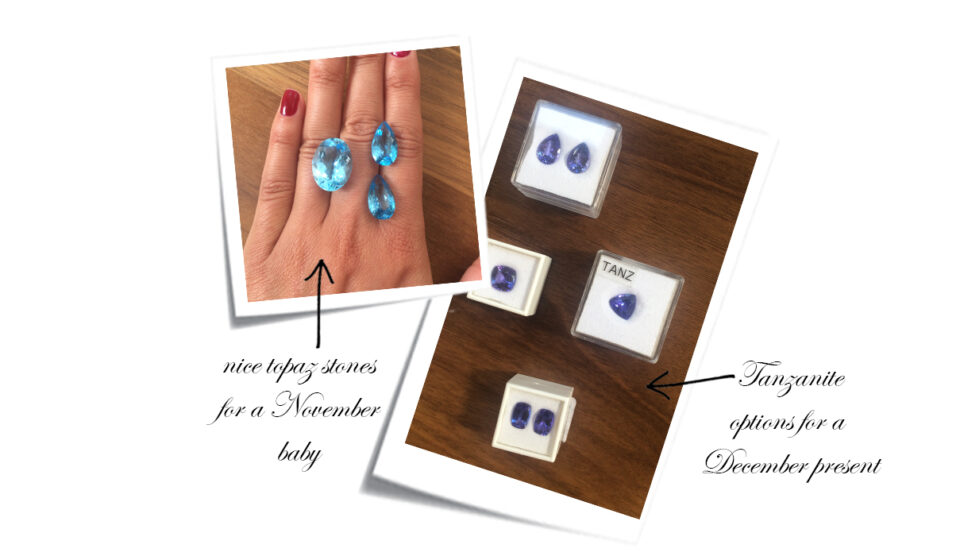
Our Source-It-Service begins at £50. Many clients like to choose a gemstone that corresponds to the recipient’s birth month, whilst others will go with a favourite colour or a classic, fail-safe choice such as a white diamond. Whatever the brief, the client sets the budget and we find the perfect stone to match.
Each chosen gemstone comes with its own informative booklet which details what it is, where it comes from and how to keep it clean. If preferred, gift certificates can also be purchased for our Source-It-Service, allowing the recipient to choose their own gemstone themselves.

We also hold a wide stock of heart-shaped gemstones, ranging in price from £25 upwards. When it comes to Valentine’s Day, they are an infinitely more interesting (and timeless) offering than a box of chocolates.

CUSTOMISATION
At Tessa Packard London we completely appreciate the importance of individuality at all price points.
Sometimes, there just isn’t the need to go fully bespoke as something in our stock collections perfectly fits the bill. What you would like, however, is to add your own touch to the piece. This is where customisation comes in.
Customisation can take many forms, but the most common examples are:
♦ Adding gemstones
Many clients like to add a small (or large) gemstone(s) to a stock design to give the piece a more bespoke, personalised feel. We are most often asked to add diamonds or birthstones to charms, pendants and necklaces, but can of course accommodate any request, as long as it is feasible to do so.
Below is a commission we completed for a client who wanted to customise three cloud charms with bespoke birthstones for three best friends.

♦ Swapping gemstones
We all have favourite colours, as well as hues and tones we would never wish to wear. Sometimes a client will love a design in our stock collection – for example an amethyst ring – but prefer it was made with a blue stone, such as a topaz or aquamarine. On these occasions we will happily customise the piece in question by either making it anew with the client’s chosen stone, or we will simply swap one out for the other.
Illustrated is a pair of customised Sweet Heart Earrings in pink quartz. This earring style usually comes in topaz, amethyst or smokey quartz as standard, but can be adapted to suit any other oval stone.

♦ Adding a bespoke disc or tag
One way of easily turning a stock necklace or pendant into a more ‘bespoke’ necklace or ‘bespoke’ pendant is by adding an engraved or gem-set tag / disc to the design. This can be added at the clasp for a more subtle touch or added to the front of the chain to create a feature. Our Trick-or-Treat decagonal discs make particularly good candidates for customisation – they hold enough room for engraving or stones to be set as desired. They are also thick enough to have both sides of the disc decorated – many of our clients choose to engrave one side and set a stone on the other.
♦ Changing the function of a design
Because many of our stock designs are cast from moulds, it’s easy to turn a pair of earrings into customised cufflinks or adapt a couple of metal charms into bespoke stud earrings – the fittings and fixtures just need changing.
Shown below is a pair of silver and diamond Sweet Tooth Cufflinks. The ‘tooths’ originally started life as pendants on a necklace in our Fat Free collection. The client loved their smiling faces so much that he asked we make Sweet Tooth Cufflinks for him to wear.
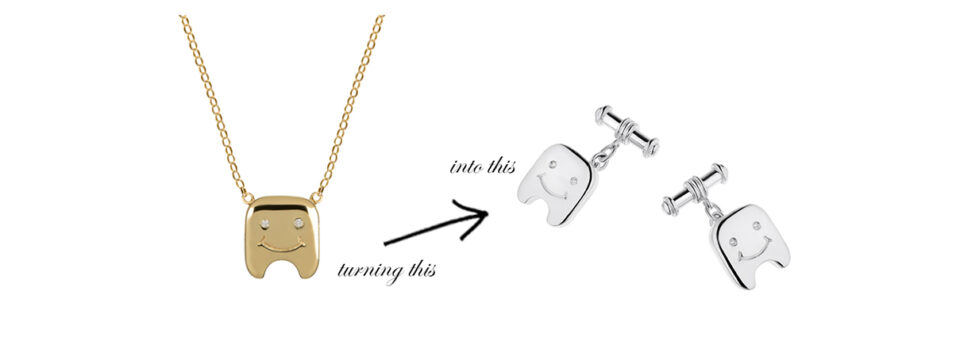
♦ Changing the metal colour
Some people prefer silver, some people prefer gold. Others have allergies that only allow them to wear platinum or the highest quality gold. For that reason, we feel it is important that we allow our clients to be able to purchase our stock pieces in the metal of their choice when possible. Whilst not all pieces can be made in silver instead of rose gold, or yellow gold instead of silver, we will always customise where we can.
In the past we have changed the metal colour of many stock collection pieces, including the illustrated bee charm. Normally sold in silver or gold vermeil, we have had the pleasure of making an 18ct yellow gold necklace adorned with gold bees as well as an 18ct white gold bee pendant with little blue sapphire eyes.
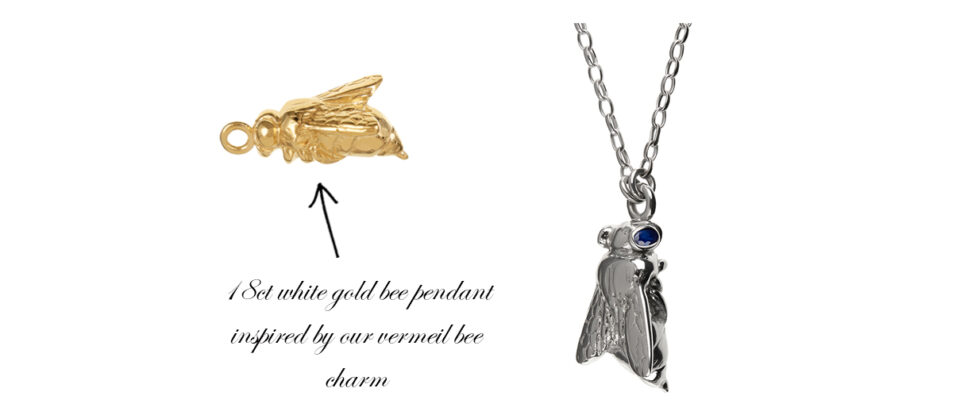
♦ Home accessories
Every so often a private or corporate client asks if we are able to apply one of our signature charms to a piece of homeware. The answer is very much yes! To date we have transported our silver bees onto tray handles, key fobs and photo frames and accessorised leather wallets with our honeycomb motif, amongst others.

TURNING TREASURED POSSESSIONS INTO JEWELLERY
Using advanced computer technology we are able to turn cherished keepsakes and objects of organic matter into timeless jewellery or decorative table ornaments through clever 3D scanning and printing.
Here, there really is no limit here to what is possible (except perhaps objects of elephantine proportions!). Treasured possessions that would not be considered suitable for jewellery are fair game; objects can be easily scaled up or down in size as required, and even duplicated in a repeat pattern for a bracelet or necklace design; organic matter, such as a bird’s nest or favourite flower, can be immortalised forever in silver, gold, brass or bronze.
One of our favourite examples is a stick commission we completed a few years ago. A client brought us a foot-long wooden twig that his son had used throughout his childhood as his cherished toy ‘gun’, ‘fishing rod’ and ‘wand’. The client asked if we could create a life-size objet d’art of the stick in silver (as a table ornament) as well as a 9ct yellow gold version of the stick as a bangle for his wife.
After creating a digital version of the stick using 3D scanning, we created two different image files. One, life-size, was printed and cast in silver for the table ornament. The second image file saw the digital stick reduced in size to accommodate the scale required for a 7.5’’ bangle. Once this amendment was made, the smaller stick was printed and cast in gold, before being manipulated into a bangle shape for the client’s wife.

BIRTHSTONE GIFTS
Birthstones can be a really great place to start when designing bespoke jewellery, especially jewellery intended to commemorate a birthday, a christening or the arrival of a new member into the family.
Each symbolising different strengths and values, the calendar of birthstones is traditionally viewed as:

January birthstone = Garnet
This gemstone’s name derives from the Latin word ‘granatus’, meaning seed or grain because of the stone’s resemblance in hue to pomegranate seeds. Legends and folklore place garnets among the most ancient of talismans, not only prized as ornamental jewellery but also as a source of curative powers and protective energies. Many believe garnet to inspire creativity and re-energize the body.
To shop garnet jewellery please click HERE

February birthstone = Amethyst
With its historical ties to royalty and intoxication, this stone has long-represented power and privilege. As early as the Roman era, the amethyst was linked to the month of February, and by association Neptune, their water god. This gemstone later became linked to St Valentine, and to this day is said to symbolise faithful love and passion.
To shop amethyst jewellery please click HERE

March birthstone = Aquamarine
Belonging to the beryl family, the aquamarine is named after its beautiful, watery colour. Once thought to have been mermaid treasure, this stone has deep links to the sea and seafarers, who believed the stone would protect them from both the perils of the sea as well as sea sickness.
To shop aquamarine jewellery please click HERE

April birthstone = Diamond
For many, diamonds are the cream of the crop when it comes to gemstones. First discovered in India in 800BC, diamonds have long been the reason behind dispute, despoliation and divergence. Wars throughout history have been fought over mining territory as well as individual diamond specimens. From 1400 onwards the art of diamond cutting – or lapidary – was developed; today diamonds come in many different shapes with the round brilliant cut being the most common.
To shop diamond jewellery please click HERE

May birthstone = Emerald
Of all the green gemstones, the emerald is traditionally the most prized. Its lush, deep green colour has mesmerised civilizations for centuries, from the Mayans to modern day. Although regarded as one of the most popular of stones, the emerald is fragile and requires careful setting and careful wearing. It is not a stone to put under pressure or knock hard.
To shop emerald jewellery please click HERE

June birthstone = Pearl, Moonstone or Alexandrite
As gemstones go, pearls are pretty unique as they are pretty much ‘jewellery-ready’ in their natural state. They don’t need to be cut, shaped or polished in order to look their best. With its traditional pure white colour, the pearl has often, through history, been associated with purity, loyalty and chastity, and at one point believed to be the tears of the goddess Aphrodite herself.
Warming to all complexions, the pearl is a wonderful gemstone for jewellery. It lends itself easily to all forms of jewellery, including pearl necklaces, pearl earrings and pearl cufflinks for men.
To shop pearl jewellery please click HERE

Moonstone is part of the feldspar mineral family. Whilst this opalescent stone can be found in peach, pink, brown and grey, it is most commonly thought of and admired in its ‘blue’ colourless form, where the internal play of light within the gemstone creates a beautiful blue, shimmering spectre. Unsurprisingly, this stone has been highly valued throughout history by monks, shamans and spiritualists who believed moonstones to contain psychic and mystical powers inside, as demonstrated by their eerie light. Today moonstones are mined in Switzerland, Myanmar, Brazil, USA, Germany and India, amongst others.
To shop moonstone jewellery please click HERE

Emerald by day, ruby by night – the alexandrite is one unique stone! It is most celebrated for displaying one of the most remarkable colour changes in the gem world, appearing green in natural sunlight and red in artificial, incandescent light. Its major drawback is its cost – alexandrite is rare, even in small sizes. Whilst it is easy to source examples of 1mm or 2mm in size, any larger can be prohibitively expensive. It is also one of our more modern gemstones, only discovered in 1830.
To shop alexandrite jewellery please click HERE

July birthstone = Ruby
Once fabled to be the most precious of the 12 gemstones created by God, the ruby endures as a much loved, much collected gemstone. Originating from the corundum family (which includes sapphires), big rubies often fetch higher prices at auction than most flawless diamonds of an equivalent size, such is their rarity. They are historically associated with symbolising wisdom, passion and love to those who wear it, the latter two being represented by the ruby’s intense, pigeon blood red colour.
To shop ruby jewellery please click HERE

August birthstone = Peridot
The peridot is one of just a handful of gemstones that exist in only a single colour: green. Varying fractionally from bright, acid green to more subdued, earthy tones, the gemstone can also be characterised by its size as peridots rarely reach more than 3 carats in weight.
Records of the peridot in jewellery can be traced back to as early as Ancient Egypt. Nicknamed the ‘emerald of the evening’ by the Romans who noticed that the stone did not change colour in artificial light, the peridot has been held in good respect ever since. Its recent revival in contemporary jewellery can be related to the discovery of a huge deposit in Kashmir in the late 1990s, which brought to the market an unusually large supply of high quality, high carat weight peridots.
To shop peridot jewellery please click HERE

September birthstone = Sapphire
Whilst sapphires are traditionally envisioned as deep blue, this hardwearing gemstone comes in a rainbow of colours, including light pink padparadscha – one of the most valued of them all. Once thought to guard against evil and poisoning, the sapphire remains a favourite amongst fine jewellery collectors and bespoke jewellery clients, with blue sapphires being one of the most popular gemstones for engagement rings to date.
To shop sapphire jewellery please click HERE

October birthstone = Opal or Tourmaline
From bottle green to raspberry red, as well as bi-coloured or tri-coloured, the Tourmaline exists in a myriad of colours. For centuries, this stone’s meaning has been contended across the world. 18th Century Western literature notes this gemstone as being virtuous to artists, actors and other creatives; others have believed it to bring sleep-inducing powers if wrapped in silk. The tourmaline was particularly valued by alchemists who – because of the stone’s pyroelectric effect – believed it to be a gem related to the Philosopher’s Stone (a stone thought to grant enlightenment, give power over the spiritual, reconcile opposites and turn base metals into gold). In modern times the tourmaline continues to be used by tribes in Africa, America and Australia as a talisman to protect from danger.
To shop tourmaline jewellery please click HERE

The opal is October’s second birthstone and the national stone of Australia. Most commonly cut in cabochon form, this gemstone is best known for its fiery and shimmering appearance, created by light infiltrating and then reflecting off the thousands of micro silica particles found inside the stone.
Although richly tied to aboriginal culture, opals have been recorded in Western history as far back in time as Ancient Rome. Pliny, the famous Roman author, noted the opal as being a gemstone which combined the best possible characteristics of almandine, amethyst, the golden yellow of topaz and the deep blue of sapphire “so that all the colours shine and sparkle together in a beautiful combination”. Unsurprisingly, it came to be a stone associated with great luck as it was believed to possess all the best qualities of all the other coloured gemstones in one.
To shop opal jewellery please click HERE

November birthstone = Citrine or Topaz
Citrine is a wonderful, all-round yellow stone. Affordable, versatile and attractive, it is commonly used in all forms of jewellery, from rings to earrings, pendants to charms. Whilst true, natural citrine is rare, modern day citrine is not – it is created by heating amethyst quartz, turning the gemstone from purple to yellow. Like topaz, this industry practice is accepted and seen as the norm.
To shop citrine jewellery please click HERE

With its myriad of colour variations, the topaz is a highly versatile gemstone. Ranging from sky blue to deep yellow, brown and orangey-red, it is historically associated with constancy, loyalty, faithfulness and friendship. It is also a hardwearing gemstone, making it an attractive material to use in jewellery and is commonly found in all forms, from topaz earrings, topaz necklaces, topaz rings to topaz cufflinks and topaz dress studs. Much of the commercial gem-quality topaz found on the market today is treated to enhance or improve the colour of the stone. This is an industry-recognised practice and widely accepted as the norm.
To shop topaz jewellery please click HERE

December birthstone = Tanzanite or Turquoise
Turquoise is the first of two gemstones for wintry December. It is also perhaps the oldest stone in man’s history – the chosen talisman of ancient tribes, kings, shamans and warriors. Long considered a stone of protection, turquoise is continually shaped in colour and form by its environmental conditions. In ancient times, many believed it to have prophetic powers, such was its ability to react to atmospheric pressure and changing weather. Due to its opaque nature the turquoise is usually cut as a cabochon or flat slice, or used as beads or in carvings.
To shop turquoise jewellery please click HERE

Tanzanite is unique in that it is only found in one place on earth – Tanzania. It was first unearthed in 1967 by a Masai tribesman who stumbled across a cluster of highly transparent, intense violet-to-blue crystals exposed in the earth near Merelani. He subsequently alerted a fortune hunter called Manuel d’Souza, who quickly registered mining rights for this gemstone. In quick succession, other industry entrepreneurs bought up land in the area, hoping that they would become rich as a result of this new mineral deposit. To this day, tanzanites remain a very popular gemstone, especially for those December babies.
To shop tanzanite jewellery please click HERE
REPLICATION, RESIZING AND REPAIR
Being small, jewellery can easily be lost. It can also be stolen, fall off due to wear and tear or disappear under accidental circumstances (often involving alcohol or the sea).
Likewise, jewellery isn’t very good at being cut in two. A much loved, inherited ring cannot be divided between two daughters. And if a ring is much loved, chances are it will need a touch of TLC every few years to keep the gemstones shining and the metal looking its best.
At Tessa Packard London we offer a full jewellery replication, jewellery resizing and jewellery repair service for all our clients’ jewellery, whether it is a TP original or not.

To give you an idea of what we can do, here are some of our most common jewellery replication, resizing and repair jobs:
♦ Duplicate a missing earring
♦ Duplicate a missing cufflink
♦ Replicate lost or stolen jewellery from photographs or client description
♦ Repair broken necklace chains
♦ Shorten or lengthen necklace chains
♦ Resizing rings (to make the band bigger or smaller)
♦ Restringing pearls or other bead necklaces
♦ Re-polish scratched or dull gemstones
♦ Re-cut dull or damaged gemstones
♦ Change the position of a post on an earring
♦ Tighten earring scrolls
♦ Replace lost earring fittings
♦ Polish out scratches in metal jewellery
♦ Re-glue pearl jewellery
♦ Check condition and quality of metal fittings, such as claw settings holding gemstones
♦ Re-setting loose gemstones
♦ Sourcing missing gemstones
♦ Re-plating worn vermeil, brass or gold-plate jewellery
♦ Repair metal erosion (for example where a ring band has become worn down)
♦ Adding ramps or ‘speed bumps’ to the inside of rings
♦ General MOTs
♦ Professional clean and service
♦ Repairing and reconditioning silverware (such as trophies, table ornaments and other objet d’art)
CONTACT
To enquire about any of Tessa Packard London’s bespoke services please kindly email [email protected]. We are always more than happy to answer any questions you may have about our bespoke jewellery and the bespoke jewellery making process so please do not hesitate to get in touch. We reply to all enquiries within 24 hours.


